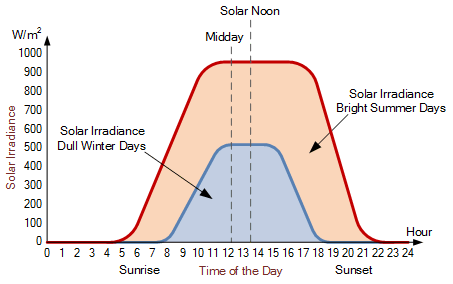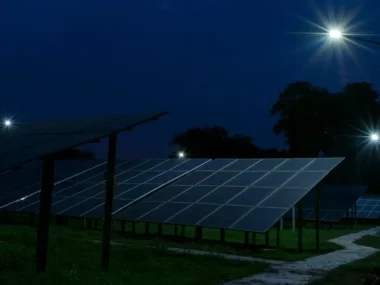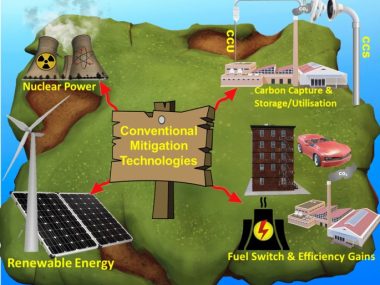The above diagram is the graph of solar Irradiance during the day,
- Solar irradiance is pivotal in our comprehension and utilization of solar power. It encompasses the radiant energy emitted by the Sun and received on Earth’s surface. This electromagnetic radiation fuels natural processes and is exploitable for human use, especially in renewable energy endeavors.
- To grasp solar irradiance, one must delve into the complex interaction of factors like Earth’s solar alignment, atmospheric conditions, and surface attributes. These variables collectively dictate the quantity of solar energy reaching specific locations at given times.
- Solar irradiance has broad relevance across various domains. In solar energy technology, it serves as a foundational metric for designing, optimizing, and evaluating solar power systems, including photovoltaic panels and solar thermal collectors. Furthermore, it plays pivotal roles in climate research, weather prediction, agriculture, and environmental studies.
- In essence, solar irradiance encapsulates the vast potential of solar energy, offering a sustainable and renewable power source that holds promise for meeting escalating energy demands while mitigating environmental repercussions.
What is solar Irradiance?
What exactly is Solar Irradiance, and how does it relate to solar photovoltaic systems? There’s a plethora of terms like solar radiation (electromagnetic), solar irradiance (for power), solar irradiation (for energy), and solar insolation, all describing the quantity of sunlight available in a specific location.
We harness the sun’s energy in various ways, such as generating electricity through photovoltaic panels or heating water with solar thermal panels, making a reliable supply of solar radiation crucial.
The sun serves as both a heat and light source, providing us with warmth and sunlight essential for life. It’s a rich energy source, but how do we determine if there’s enough radiant energy for a solar photovoltaic (PV) panel to generate electricity?
Measuring Solar Irradiance Our sun is an abundant source of radiant energy. The amount of solar energy per unit area reaching a surface at a specific angle is termed irradiance, measured in watts per square meter (W/m²), or kilowatts per square meter (kW/m²), where 1000 watts equals 1.0 kilowatts.
However, the direct distance between the Earth and the Sun varies annually, leading to fluctuations in the amount of solar irradiance energy received over a full year.
According to NASA, the average irradiance value measured at the edge of space and outside Earth’s atmosphere on a flat surface positioned perpendicular to the sun is about 1,370 watts per m² (equivalent to 1.37 kilowatts). This value, termed the Solar Constant, is used to calculate solar values on Earth’s surface.
However, irradiance values measured across Earth’s surface are typically lower than the solar constant. Scattering and reflection of sunlight as it passes through the atmosphere decrease the amount of energy reaching the surface due to various climatic conditions.
Irradiation through the Atmosphere
For instance, yearly factors like the season, temperature fluctuations, cloudy weather, and the angle of the sun’s rays hitting the ground all affect the amount of solar irradiance accessible at a given spot.
As sunlight penetrates our atmosphere and reaches the Earth’s surface at sea level, it’s measured as the maximum solar irradiance across a 1m² flat surface. Therefore, around solar noon on a clear day at an equatorial position, the recorded solar radiation typically stands at approximately 1000 watts per square meter, or 1000W/m² (equivalent to 1.0 kW/m²).
In the context of photovoltaic solar panels solely aimed at generating solar power, a solar irradiance level of 1.0 kW/m² is referred to as one “Full Sun,” commonly termed “Peak Sun.” Consequently, “Peak Sun Hours” (PSH) signifies the duration during which this full sun solar irradiance level of 1.0 kW/m² was received at the panel’s surface.
Nonetheless, when solar radiation is averaged over the complete 24-hour day-night cycle and across a whole year, even prime locations typically receive only 250–300 W/m² daily on average. This amount is less than 30% of what reaches the Earth’s atmosphere’s top. Hence, there’s considerable “solar attenuation,” meaning the loss of solar irradiance as it traverses the Earth’s atmosphere before reaching the surface, with greater attenuation occurring during winter months.












